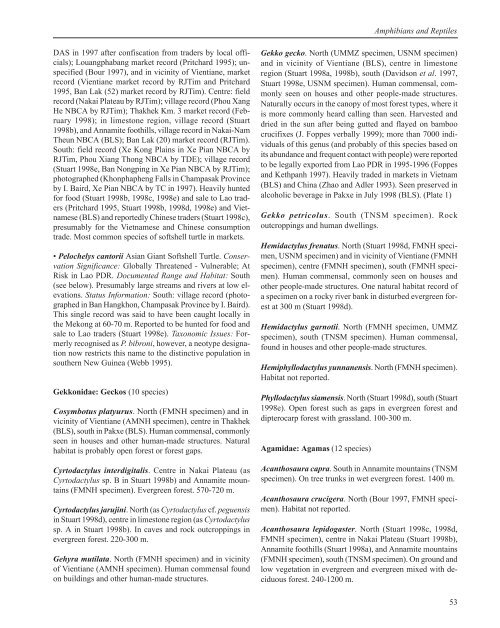Wildlife of Lao PDR: 1999 Status Report - IUCN
Wildlife of Lao PDR: 1999 Status Report - IUCN
Wildlife of Lao PDR: 1999 Status Report - IUCN
You also want an ePaper? Increase the reach of your titles
YUMPU automatically turns print PDFs into web optimized ePapers that Google loves.
DAS in 1997 after confiscation from traders by local <strong>of</strong>ficials);<br />
Louangphabang market record (Pritchard 1995); unspecified<br />
(Bour 1997), and in vicinity <strong>of</strong> Vientiane, market<br />
record (Vientiane market record by RJTim and Pritchard<br />
1995, Ban Lak (52) market record by RJTim). Centre: field<br />
record (Nakai Plateau by RJTim); village record (Phou Xang<br />
He NBCA by RJTim); Thakhek Km. 3 market record (February<br />
1998); in limestone region, village record (Stuart<br />
1998b), and Annamite foothills, village record in Nakai-Nam<br />
Theun NBCA (BLS); Ban Lak (20) market record (RJTim).<br />
South: field record (Xe Kong Plains in Xe Pian NBCA by<br />
RJTim, Phou Xiang Thong NBCA by TDE); village record<br />
(Stuart 1998e, Ban Nongping in Xe Pian NBCA by RJTim);<br />
photographed (Khonphapheng Falls in Champasak Province<br />
by I. Baird, Xe Pian NBCA by TC in 1997). Heavily hunted<br />
for food (Stuart 1998b, 1998c, 1998e) and sale to <strong>Lao</strong> traders<br />
(Pritchard 1995, Stuart 1998b, 1998d, 1998e) and Vietnamese<br />
(BLS) and reportedly Chinese traders (Stuart 1998c),<br />
presumably for the Vietnamese and Chinese consumption<br />
trade. Most common species <strong>of</strong> s<strong>of</strong>tshell turtle in markets.<br />
• Pelochelys cantorii Asian Giant S<strong>of</strong>tshell Turtle. Conservation<br />
Significance: Globally Threatened - Vulnerable; At<br />
Risk in <strong>Lao</strong> <strong>PDR</strong>. Documented Range and Habitat: South<br />
(see below). Presumably large streams and rivers at low elevations.<br />
<strong>Status</strong> Information: South: village record (photographed<br />
in Ban Hangkhon, Champasak Province by I. Baird).<br />
This single record was said to have been caught locally in<br />
the Mekong at 60-70 m. <strong>Report</strong>ed to be hunted for food and<br />
sale to <strong>Lao</strong> traders (Stuart 1998e). Taxonomic Issues: Formerly<br />
recognised as P. bibroni, however, a neotype designation<br />
now restricts this name to the distinctive population in<br />
southern New Guinea (Webb 1995).<br />
Gekkonidae: Geckos (10 species)<br />
Cosymbotus platyurus. North (FMNH specimen) and in<br />
vicinity <strong>of</strong> Vientiane (AMNH specimen), centre in Thakhek<br />
(BLS), south in Pakxe (BLS). Human commensal, commonly<br />
seen in houses and other human-made structures. Natural<br />
habitat is probably open forest or forest gaps.<br />
Cyrtodactylus interdigitalis. Centre in Nakai Plateau (as<br />
Cyrtodactylus sp. B in Stuart 1998b) and Annamite mountains<br />
(FMNH specimen). Evergreen forest. 570-720 m.<br />
Cyrtodactylus jarujini. North (as Cyrtodactylus cf. peguensis<br />
in Stuart 1998d), centre in limestone region (as Cyrtodactylus<br />
sp. A in Stuart 1998b). In caves and rock outcroppings in<br />
evergreen forest. 220-300 m.<br />
Gehyra mutilata. North (FMNH specimen) and in vicinity<br />
<strong>of</strong> Vientiane (AMNH specimen). Human commensal found<br />
on buildings and other human-made structures.<br />
Gekko gecko. North (UMMZ specimen, USNM specimen)<br />
and in vicinity <strong>of</strong> Vientiane (BLS), centre in limestone<br />
region (Stuart 1998a, 1998b), south (Davidson et al. 1997,<br />
Stuart 1998e, USNM specimen). Human commensal, commonly<br />
seen on houses and other people-made structures.<br />
Naturally occurs in the canopy <strong>of</strong> most forest types, where it<br />
is more commonly heard calling than seen. Harvested and<br />
dried in the sun after being gutted and flayed on bamboo<br />
crucifixes (J. Foppes verbally <strong>1999</strong>); more than 7000 individuals<br />
<strong>of</strong> this genus (and probably <strong>of</strong> this species based on<br />
its abundance and frequent contact with people) were reported<br />
to be legally exported from <strong>Lao</strong> <strong>PDR</strong> in 1995-1996 (Foppes<br />
and Kethpanh 1997). Heavily traded in markets in Vietnam<br />
(BLS) and China (Zhao and Adler 1993). Seen preserved in<br />
alcoholic beverage in Pakxe in July 1998 (BLS). (Plate 1)<br />
Gekko petricolus. South (TNSM specimen). Rock<br />
outcroppings and human dwellings.<br />
Hemidactylus frenatus. North (Stuart 1998d, FMNH specimen,<br />
USNM specimen) and in vicinity <strong>of</strong> Vientiane (FMNH<br />
specimen), centre (FMNH specimen), south (FMNH specimen).<br />
Human commensal, commonly seen on houses and<br />
other people-made structures. One natural habitat record <strong>of</strong><br />
a specimen on a rocky river bank in disturbed evergreen forest<br />
at 300 m (Stuart 1998d).<br />
Hemidactylus garnotii. North (FMNH specimen, UMMZ<br />
specimen), south (TNSM specimen). Human commensal,<br />
found in houses and other people-made structures.<br />
Hemiphyllodactylus yunnanensis. North (FMNH specimen).<br />
Habitat not reported.<br />
Phyllodactylus siamensis. North (Stuart 1998d), south (Stuart<br />
1998e). Open forest such as gaps in evergreen forest and<br />
dipterocarp forest with grassland. 100-300 m.<br />
Agamidae: Agamas (12 species)<br />
Amphibians and Reptiles<br />
Acanthosaura capra. South in Annamite mountains (TNSM<br />
specimen). On tree trunks in wet evergreen forest. 1400 m.<br />
Acanthosaura crucigera. North (Bour 1997, FMNH specimen).<br />
Habitat not reported.<br />
Acanthosaura lepidogaster. North (Stuart 1998c, 1998d,<br />
FMNH specimen), centre in Nakai Plateau (Stuart 1998b),<br />
Annamite foothills (Stuart 1998a), and Annamite mountains<br />
(FMNH specimen), south (TNSM specimen). On ground and<br />
low vegetation in evergreen and evergreen mixed with deciduous<br />
forest. 240-1200 m.<br />
53

















